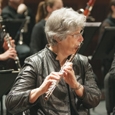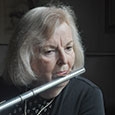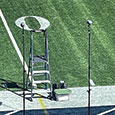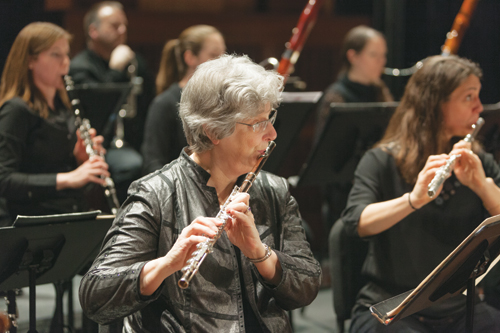
This fall Katherine Borst Jones celebrates 30 years as professor of flute at The Ohio State University. She is a founding member and co-principal flutist of the ProMusica Chamber Orchestra, a founding member of the COSMOS trio (flute, viola and harp) and the Jones/Norton Duo with harpist Jeanne Norton. She is also a member of the Columbus Symphony Orchestra and principal flute of the New Sousa Band, which performed at the 2009 WASBE and Midwest Clinic and has toured Japan, China and the United States extensively. Jones, a native of New Jersey, is a graduate of the University of New Hampshire and The Ohio State University. Her principal teachers included Keith Brion, Robert Willoughby, Kyril Magg, Donald E. McGinnis, and Julius Baker.
What teaching philosophies have you developed after 30 years at The Ohio State University?
I try to teach students to be their own teacher, to take responsibility for practicing and performance, and to have respect for themselves. Each person has a voice that should be heard. Students must find their passions, whether it be a particular style of music, a certain composer, or a combination. All the members of the flute family should be explored, including Baroque flute, and perhaps now ethnic flutes. The greatest reward for any teacher is to see the success and happiness of former students.
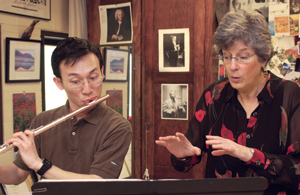 What is your basic curriculum for a performance or music education major for the BM program?
What is your basic curriculum for a performance or music education major for the BM program?
Basic goals include mastery of the fundamentals and pedagogy of flute playing. This includes rhythm, body mapping, breathing, tone, vibrato, articulation, finger technique, legato, phrasing and sightreading. Every graduating flutist also should have a working knowledge of the standard flute repertoire including chamber, orchestral and band works. Students should have a strong background historically and be familiar with the primary sources related to the flute’s history and performance style practices. They should learn and perform works from all style periods including learning contemporary techniques and should have performing experiences in chamber music and in flute choir. I also encourage students to explore entrepreneurial issues so they will find employment in the future. Flute alums come back to campus to share their real life experiences with current students.
For example, with first year students, I assign studies and etudes by Taffanel & Gaubert, Maquarre, Moyse, Filas, Colin, Andersen, Berbiguier, Hugues and Kohler. Repertoire may include: Bach Sonata in Eb, Bloch Suite Modale, Busser Prelude et Scherzo, Chaminade Concertino, Debussy Syrinx, Delibes/Massenet Three Original Pieces, Doppler Fantaisie Pastorale Hongrouise, Gaubert Madrigal, Griffes Poem, Hindemith Sonate, Honegger Danse de la Chevre, Hoover Kokopeli/Winter Spirits, Ibert Aria, Koechlin Fourteen Pieces, Molique Andante, Mozart Andante in C, Pergolesi Concerto in G, Stamitz Concerto in G, Telemann Suite in A Minor, Telemann Sonatas in F and G Major, and Whear Five Haiku plus standard orchestral excerpts.
Do you teach any special tone exercises?
Yes, I have an exercise that incorporates the ideas of Julius Baker, Marcel Moyse and Keith Brion (pdf). It features the traditional half-steps, five-tone scales ascending slowly with a big, beautiful sound, and then adds harmonics into the mix using all the partials. When students work to match the color of the harmonic to the regular fingering, both the color and the pitch is improved. I have had great success with students who practice this exercise every day. The next step is to use harmonics as a way of improving sound and pitch in repertoire, etudes, and excerpts.
What role does flute choir have in your studio?
The Ohio State University Flute Troupe (flute choir) is a big part of my curriculum. Frequent studio classes and playing in a flute choir together inspires cooperation among the students. They learn to work together for the same goal and discover that each has a different strength to share. Through it they also learn that they can be colleagues and friends. Sometimes personality conflicts arise, but working and learning together lessens the chance of problems. Flute choir teaches skills of many types such as intonation, blend, the role of the melody vs. harmony, the function of a bass line, and often how to sightread and learn music well but quickly. Older students become role models and mentors for younger students. Consequently younger students hear where they want to be, and most work harder to get there.
What are your thoughts on the DMA document?
The DMA document should serve as a jumping off point for a student’s career. The topic should be of interest to others. Perhaps it is a one that flute clubs might find interesting for a future lecture or recital. It might just be something new that has not been explored. As I work with students, I try to help them find and explore their interests, passions, and talents beyond just flute playing. They may be interested in the music of a certain composer, or from their country of origin. An interest in pedagogy may lead to a study of Alexander Technique or body mapping. We work together to find a particular interest that will serve them in the future. Recent topics by my students include:
An Introduction to Twentieth-Century Flute Music by Norwegian Composers
Flute Articulation Pedagogy: The Effect of Language-Specific Consonant Pronunciation on a Flutist’s Articulation within the French and English Languages
A Supplementary Book of Chinese for the Suzuki Flute Student
The Evolving Mission and Purpose of the Pittsburgh Flute Club in the Twentieth Century
An Illustrated Basic Flute Repair Manual for Professionals
The Commissioned Works of the National Flute Association for the Young Artist and High School Soloist Competitions
The professional life and pedagogy of Donald E. McGinnis, PhD
Lûos Janácek’s wind sextet, Mládí: a history of an interpretive source and suggestions for performance
The application of different teaching strategies reflective of individual students’ learning modality
The professional life and pedagogy of Clement Barone
Flutists’ family tree: in search of the American Flute School
The piccolo in the chamber music of the twentieth century: an annotated bibliography of selected works
What every flute teacher needs to know about the body: a handbook applying the principles of body mapping to flute pedagogy
The New York Woodwind Quintet: a continuing legacy
Antoine Reicha’s quartets for flute and strings, op. 98: an historical perspective and stylistic overview.
How did you start your summer flute workshop?
In 1976 I began teaching as an adjunct teacher at Capital University in Columbus, Ohio. The first year I only had one student, so clearly I needed to recruit. The next summer I hosted the first Flute Workshop. I thought maybe fifteen students would come but fifty showed up, and the enrollment has continued to be strong through the years. The workshop is based on learning and performing chamber music. Each flutist is placed in a small flute ensemble that is coached twice a day by my current OSU flute majors and alumni. Other activities include theory, conducting, private lessons, solo night, jazz class etc. All students participate in the final concert that showcases the small ensembles and includes a flute choir comprised of all the flutists. The camp runs Sunday afternoon through Thursday afternoon, and everyone who applies is accepted. Any flutist with the interest and passion has the opportunity to learn. Of all my accomplishments, I am proudest of this one.
Why are courses in entrepreneurship important in the university curriculum?
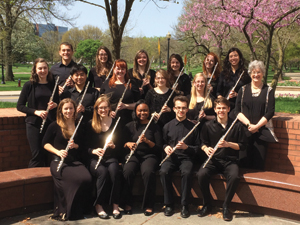 With the current tight job market, flutists need to explore career opportunities beyond teaching at the college level or performing with a symphony. The time has come for many musicians to run their own businesses. I think it is an exciting time to develop your own company with initiatives you care about. First you must identify a problem and then figure out how to solve it with a project. You should learn to write a business and marketing plan, construct a website, build a team of like-minded people to help you, learn to write grants, make cold phone calls, and construct a development plan. Students who are interested in this should take business classes and apply for summer internship programs.
With the current tight job market, flutists need to explore career opportunities beyond teaching at the college level or performing with a symphony. The time has come for many musicians to run their own businesses. I think it is an exciting time to develop your own company with initiatives you care about. First you must identify a problem and then figure out how to solve it with a project. You should learn to write a business and marketing plan, construct a website, build a team of like-minded people to help you, learn to write grants, make cold phone calls, and construct a development plan. Students who are interested in this should take business classes and apply for summer internship programs.
What are some of the activities that have kept you studying and learning throughout your career?
My mentors, Keith Brion, Robert Willoughby and Donald E. McGinnis, were constantly learning and reinventing themselves. Besides attending conventions, flute festivals, and masterclasses, I think it is important to try things that are outside one’s comfort zone. I attended the Oberlin Baroque Performance Institute as a beginning Baroque flutist and an Andover Educators Seminar. This past summer, I was the oldest participant in David Cutler’s Savvy Musician in Action Seminar at the University of South Carolina. My suggestion is to take risks and take advantage of every opportunity. I try to stay up to date by reading the latest research and books such as Daniel Coyle’s The Talent Code.
Why should teachers be active performers?
Teaching feeds performing. Performing feeds teaching. I feel most fortunate to have a healthy balance between the two. My full-time position is at the university, therefore, my teaching comes first. Byproducts of performing include learning new music, getting ideas from colleagues, and allowing students to hear me outside the studio. With my COSMOS trio, we have been able to commission American composers such as Libby Larsen, Stephen Paulus, Andrew Boysen and others. Working with composers directly is enriching for all. A special benefit is that my students have the opportunity to meet these composers when we premiere the pieces.
How do you find practice time for yourself so you can play these concerts?
When I was a student, I maintained a disciplined practice schedule. Now my practice time is limited, so I practice as efficiently as I can whenever I find a moment. I do short bursts of practice throughout the day, and weekends and summers provide extended practice time.
What advice do you have for a high school flutist who wants a career in flute performance?
Practice, listen to your teacher and conductors, play in youth groups, attend flute festivals, masterclasses, summer workshops, and conventions. Read about music and composers. Listen, listen, listen to great musicians of all kinds, especially to singers. Perform frequently. Look for opportunities to explore other aspects of the music business such as serving as a volunteer or intern for a local arts organization. Being an active member of NFA is also part of becoming a professional flutist. I attended the 4th NFA convention in Atlanta and have not missed one since. NFA offers flutists the chance to network, to learn new repertoire, to hear different playing styles, and to learn about different pedagogical styles. Maintain excellent grades as many universities are academically competitive. If music is your passion, go for it!
How did you meet Keith Brion?
Keith Brion, conductor and founder of the New Sousa Band, was my high school band director and flute teacher in Caldwell, New Jersey. He established a private lesson program in which I participated. When a lesson is provided, you must be ready or the lessons could stop, so I worked hard. In tenth grade I became a member of the concert band that met all school year. We performed great literature, including music by Grainger, Sousa, Holst, Handel and others. We worked with Alan Hovhaness to premiere his Suite for Band. We took a field trip to see the New York City Ballet perform The Firebird by Igor Stravinsky. By junior year I was hooked. I proudly stated to Mr. Brion, “I want to major in music.” He said, “How will you make a living?” I persisted and worked hard to prove I was serious. By senior year I was in the New Jersey Junior Symphony, All State Band and had been given the Lincoln Center Student Award which allowed me to attend six free events at Lincoln Center with a colleague. On a marching band trip, I was called to the front of the bus and told by him, “I think you should audition for Oberlin College where the flute teacher is Robert Willoughby,” and a new dream emerged.
Did you indeed apply to Oberlin?
Yes, but I was not accepted. Instead, I attended the University of New Hampshire where I became a big fish in a small pond. It worked out well though, as I was afforded many unusual performing opportunities, often with faculty members. For example, I performed the complete Bach and Handel Sonatas with a faculty harpsichordist in a four-concert series in the local art gallery and took an independent study course with the renowned musicologist Mary Rasmussen where we read through hundreds of flute/piano pieces over the course of two years. I attended a series of concerts of the complete piano works of Claude Debussy given by Beverage Webster and had the privilege of meeting, speaking with and hearing French flutist Jean-Pierre Rampal in our own recital hall.
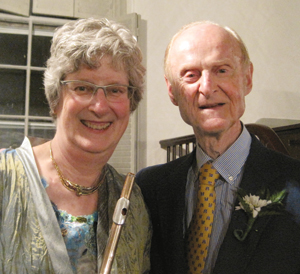 One day I spotted a poster advertising the Dartmouth College Congregation of the Arts summer program. Listed under faculty was Robert Willoughby! This was my chance. Without telling a soul, I took the bus to Boston and auditioned. Eventually the acceptance letter came along with a small scholarship. Fortunately my parents supported me, and I was finally off to study with the great teacher. I ended up studying with Mr. Willoughby for an eight-week session each of two separate summers. Those lessons changed my life. What I learned from him made my career possible. Ironically, years later I taught at the Oberlin Conservatory for three years as Willoughby’s colleague. I am fortunate that he has been a steady influence and mentor ever since. Years later I organized a summer class for him to teach so more students would have the opportunity to work with this master musician and teacher.
One day I spotted a poster advertising the Dartmouth College Congregation of the Arts summer program. Listed under faculty was Robert Willoughby! This was my chance. Without telling a soul, I took the bus to Boston and auditioned. Eventually the acceptance letter came along with a small scholarship. Fortunately my parents supported me, and I was finally off to study with the great teacher. I ended up studying with Mr. Willoughby for an eight-week session each of two separate summers. Those lessons changed my life. What I learned from him made my career possible. Ironically, years later I taught at the Oberlin Conservatory for three years as Willoughby’s colleague. I am fortunate that he has been a steady influence and mentor ever since. Years later I organized a summer class for him to teach so more students would have the opportunity to work with this master musician and teacher.
Who else has been a mentor for you?
Other strong influences have been Kyril Magg and Donald E. McGinnis, who I worked with during my graduate years at Ohio State. Dr. McGinnis, the legendary director of The Ohio State University Concert Band, offered me a graduate teaching assistant position which provided me with many other amazing opportunities. I am so privileged that all my mentors are still living. I am grateful to each of them for all they have given me over the years. Without them, I am sure life would have been different for me. They ignited my passion for the flute and music and challenged me to fulfill my potential. They have provided inspiration, counsel, and encouragement when needed.
* * * * *
Honors and Appointments
In 1999 Jones was appointed chair of the woodwinds, brass and percussion at The Ohio State University, and in 2010 she also became chair of orchestral instruments. She was awarded the School of Music Distinguished Teacher award in 1995 and 2012, and the Distinguished Scholar Award in 2008.
She has served the NFA as president twice, vice-president, program chair (Los Angeles 1992), and is the current chair of development. In 2011 she received the NFA Distinguished Service Award.
